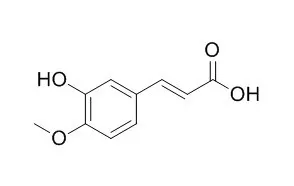| In vitro: |
| Anticancer Agents Med Chem. 2015;15(8):980-7. | | Anticancer Candidates Derived from Natural Cinnamic Acids.[Pubmed: 25634446] | Cancer is the most dangerous disease that causes deaths all over the world. Natural products have afforded a rich source of drugs in a number of therapeutic fields including anticancer agents. Many significant drugs have been derived from natural sources by structural optimization of natural products. Cinnamic acid has gained great interest due to its antiproliferative, antioxidant, antiangiogenic and antitumorigenic potency.
METHODS AND RESULTS:
Currently, cinnamic acid and its analogs such as caffeic acid, sinapic acid, ferulic acid, and isoferulic acid(3-Hydroxy-4-methoxycinnamic acid) display various pharmacological activities, such as immunomodulation, anti-inflammation, anticancer and antioxidant. They have served as a major source of potential anticancer lead compounds.
CONCLUSIONS:
In this review, we focus on the anticancer potency of cinnamic acid derivatives and novel strategies for the design of these derivatives. We hope this review will be useful for researchers who are interested in developing anticancer agents. | | Nat Prod Commun. 2011 Sep;6(9):1285-8. | | Evaluation of antioxidant activity of isoferulic acid in vitro.[Pubmed: 21941899] | Isoferulic acid (3-Hydroxy-4-methoxycinnamic acid, IFA), the isomer of ferulic acid (4-hydroxy-3-methoxycinnamic acid), is a rare phenolic acid occurring in Rhizoma Cimicifugae. Unlike ferulic acid, which has been well investigated, the antioxidant activity of 3-Hydroxy-4-methoxycinnamic acid has not been measured.
METHODS AND RESULTS:
In this study, 3-Hydroxy-4-methoxycinnamic acid was systematically evaluated for its in vitro antioxidant activity for the first time. IC50 values were calculated of 7.30 +/- 0.57, 4.58 +/- 0.17, 1.08 +/- 0.01, 8.84 +/- 0.43, 7.69 +/- 0.39, 1.57 +/- 0.2, 13.33 +/- 0.49 microg/mL, respectively, for lipid peroxidation, DPPH (1,1-diphenyl-2-picrylhydrazyl radical) and ABTS (3-ethylbenzthiazoline-6-sulfonic acid diammonium salt) radical scavenging, reducing power on Fe3+ and CU2+ ions, and hydroxyl and superoxide anion radical scavenging.
CONCLUSIONS:
Comparison with the IC50 values with those of the positive controls, Trolox and butylated hydroxyanisole (BHA), it can be concluded that 3-Hydroxy-4-methoxycinnamic acid is an effective natural antioxidant in both lipid and aqueous media. |
|






 Cell. 2018 Jan 11;172(1-2):249-261.e12. doi: 10.1016/j.cell.2017.12.019.IF=36.216(2019)
Cell. 2018 Jan 11;172(1-2):249-261.e12. doi: 10.1016/j.cell.2017.12.019.IF=36.216(2019) Cell Metab. 2020 Mar 3;31(3):534-548.e5. doi: 10.1016/j.cmet.2020.01.002.IF=22.415(2019)
Cell Metab. 2020 Mar 3;31(3):534-548.e5. doi: 10.1016/j.cmet.2020.01.002.IF=22.415(2019) Mol Cell. 2017 Nov 16;68(4):673-685.e6. doi: 10.1016/j.molcel.2017.10.022.IF=14.548(2019)
Mol Cell. 2017 Nov 16;68(4):673-685.e6. doi: 10.1016/j.molcel.2017.10.022.IF=14.548(2019)